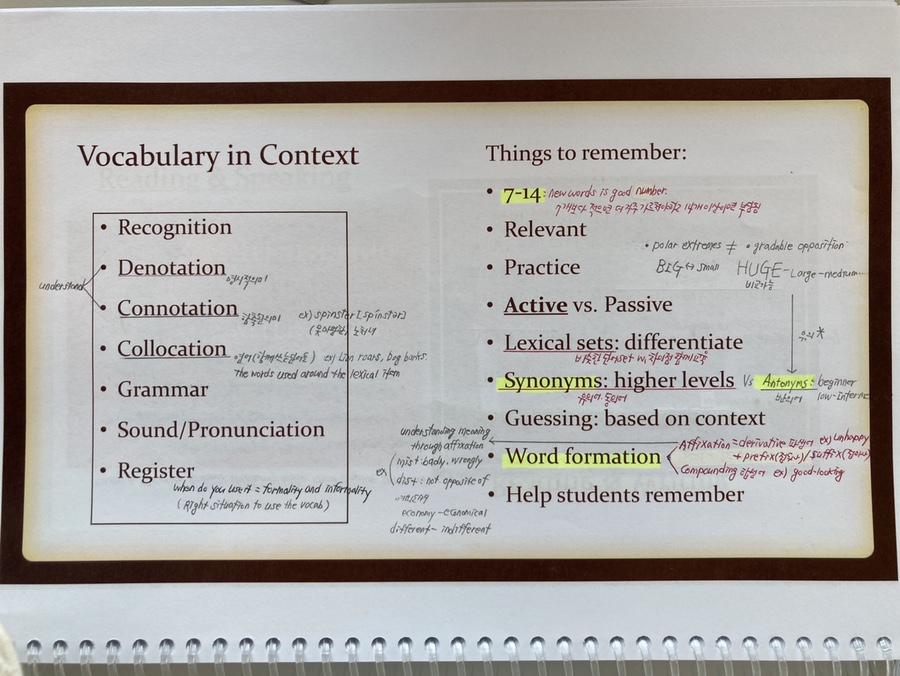WVC 테솔자격증(unit8-11)
Unit 8
Teaching Reading
Reading strategies _ 읽기전략

Scanning(찾아읽기)
To find a specific point/item
VS.
Skimming(훑어읽기)
To get a general idea of what is about
스캐닝과 스키밍은 모든 단어를 읽지 않기 때문에
하나하나 다 읽는 Reading for detail과 다르지요
Intensive Reading- detail/ specific info.
디테일, 세부 정보를 위해 자세히 읽는 것
Step 1. Creat interest
Step 2. Pre-teach(7-10 unknown words)*
Step 3. Reading task(Authentic vs. Created)
Graded Reader is one type of created.
Step 4.Follow up activities
(ex: true/false, word search-cloze, guided writing, asking, summarize, finish the story...)
VS.
Extensive Reading- fun/fluency
전체적인 이해/재미를 위해 술술 읽는 것
Tip1.
*unit8_chapter 9_p162에는
모르는 단어를 7-10개로 제안하지만
선생님 pdf 수업자료에는 7-14개로 표기됩니다
퀴즈의 정답은 선생님 수업을 참고하세요!

차이점을 중심으로 이해하면 쉬워요
Denotation(명시적) vs. Connotation(함축적)
Register (formality vs. informality)
Active(적극사용) vs. Passive(사용X)
Synonyms(유의어) vs. Antonyms(반의어)
예시를 통해 이해하면 쉬워요
Collocation(연어_ex: Dog barks)
Lexical set(ex: 교통수단-버스, 자동차,기차..)
Word formation(단어형성법)
Tips 2.
Antonyms(반의어)
Polar extremes: Tall- Short
Gradable: Huge-Large-Medium-Small..
Word formation(단어합성)
Affixation(파생어)= prefix(접두)+suffix(접미)
Compounding (합성어)
더보기
https://blog.naver.com/wvc_online/222407611121
Teaching Reading
Reading strategies _ 읽기전략

Scanning(찾아읽기)
To find a specific point/item
VS.
Skimming(훑어읽기)
To get a general idea of what is about
스캐닝과 스키밍은 모든 단어를 읽지 않기 때문에
하나하나 다 읽는 Reading for detail과 다르지요
Intensive Reading- detail/ specific info.
디테일, 세부 정보를 위해 자세히 읽는 것
Step 1. Creat interest
Step 2. Pre-teach(7-10 unknown words)*
Step 3. Reading task(Authentic vs. Created)
Graded Reader is one type of created.
Step 4.Follow up activities
(ex: true/false, word search-cloze, guided writing, asking, summarize, finish the story...)
VS.
Extensive Reading- fun/fluency
전체적인 이해/재미를 위해 술술 읽는 것
Tip1.
*unit8_chapter 9_p162에는
모르는 단어를 7-10개로 제안하지만
선생님 pdf 수업자료에는 7-14개로 표기됩니다
퀴즈의 정답은 선생님 수업을 참고하세요!

차이점을 중심으로 이해하면 쉬워요
Denotation(명시적) vs. Connotation(함축적)
Register (formality vs. informality)
Active(적극사용) vs. Passive(사용X)
Synonyms(유의어) vs. Antonyms(반의어)
예시를 통해 이해하면 쉬워요
Collocation(연어_ex: Dog barks)
Lexical set(ex: 교통수단-버스, 자동차,기차..)
Word formation(단어형성법)
Tips 2.
Antonyms(반의어)
Polar extremes: Tall- Short
Gradable: Huge-Large-Medium-Small..
Word formation(단어합성)
Affixation(파생어)= prefix(접두)+suffix(접미)
Compounding (합성어)
더보기
https://blog.naver.com/wvc_online/222407611121

